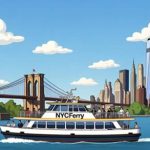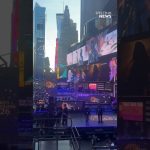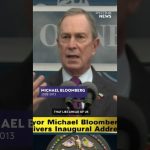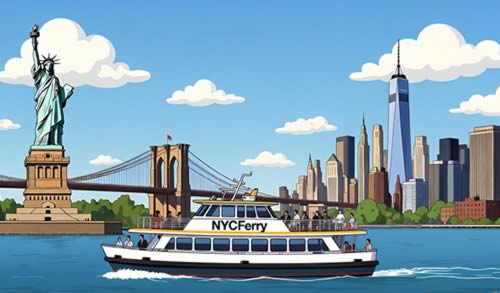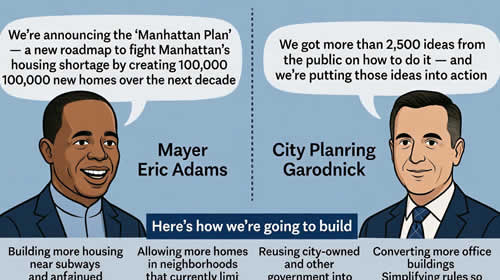Mayor Eric Adams: Good morning. Commissioner Iscol is one of my favorite commissioners, but whenever I am here in this room, it’s a problem. Yesterday, New Yorkers saw and smelled something that has never impacted us on this scale before. Even as I was out walking the streets, clearly, you knew something was happening that was beyond normal. The screenshots really show you the mist and the clouds that was over our city. We had dangerously high levels of wildfire smoke from thousands of miles away, thousands of miles away, from the gloom over Yankee Stadium to the smoky haze obscuring our skyline. We could see it, we could smell it, and we felt it, and it was alarming and concerning.
Last night at 10 p.m, the Air Quality Index hit 218, a very unhealthy level. On the levels of health concern, it really sent shock waves throughout the entire city and this region. And this morning at 7 a.m, the Air Quality Index was 174 in the Bronx and will remain around that level for at least another day. But this is an unprecedented event in our city and New Yorkers must take precaution.
The New York State Department of Environmental Conservation has issued an air quality health advisory for all five boroughs. Our team is coordinating and First Deputy Mayor Sheena Wright will go into that coordination, but at the moment, we recommend vulnerable New Yorkers stay inside and all New Yorkers should limit outdoor activity to the greatest extent possible. This is not the day to train for a marathon or to do an outside event with your children. Stay inside closed windows and doors and use air purifiers if you have them. If you are older or have heart or breathing problems or an older adult, you should remain inside. And if you must go outdoors, wear high-quality masks, such as a K-95.
Our students are in school today, but the chancellor has canceled all outside events as an abundance of caution. These recommendations may change. This is a moving situation and we will keep New Yorkers informed on any changes based on updated air quality conditions. In the meantime, we recommend all New Yorkers take the precautions that they see fit to protect their health. Air quality conditions are anticipated to temporarily improve later tonight through tomorrow morning, but they are expected to deteriorate further tomorrow afternoon and evening.
We want everyone to check the air quality forecast from local media outlets, the National Weather Service, or other weather air quality apps that you can access on the go. While this may be the first time we’ve experienced something like this on this magnitude, let’s be clear, it is not the last. Climate change has accelerated these conditions and we must continue to draw down emissions, improve air quality, and build resiliency. ( BigNY.com – what is connection ???? )
New York City is clearly a national leader on public health and climate action. And these dangerous air quality conditions are clearly an urgent reminder that we must act now to protect our city, our environment, and the future of our children. Finally, I’d like to point out that we have the city’s best doctors and hospital administrators working on our team. We have the best emergency management, the best climatologists, and many other skilled and dedicated people working for the city and helping make these decisions. I urge all New Yorkers to listen to them and draw on their expertise as we cycle through this issue. Now, I want to turn it over to the Emergency Management commissioner, Commissioner Iscol.
( BigNY.com – The amount of carbon dioxide emitted as a result of improper fire prevention measures in Canada, leading to massive wildfires, has resulted in emissions that are tens of times greater than the reduction of CO2 emissions from all the “climate-related” initiatives of New York City over a hundred years, judging by the estimated emission figures. )
Commissioner Zachary Iscol, New York City Emergency Management: Thank you, sir. Good morning, everybody. Thank you. Thank you, Mr. Mayor. Thanks for being here today to talk about this smoke issue here in New York City. So as many of you know, smoke traveling from the current wildfires along the Canadian border has significantly impacted air quality here in New York City and throughout the northeast.
This is something that began to rapidly deteriorate yesterday afternoon. Smoke is something that is notoriously difficult to forecast. Unlike weather, there’s a lot more variables that go into the creation of smoke, for one, the amount of fire being created on the ground, the ability of firefighters to actually put out those fires, what is actually burning. And then in addition to that, you have all the complexities of the forecasting of the weather systems that could then drive that smoke into this area.
And so the air quality significantly diminished, rapidly deteriorating late yesterday. As a result, New York State Department of Environmental Conservation issued an air quality health advisory, which will be extended at least until midnight tonight. We expect this to be a multiple-day event, so we expect that that advisory to remain in place for the next few days. Again, it is notoriously difficult to forecast smoke and these types of events.
As the mayor said, wildfires are growing increasingly more common around the world due to increased temperatures and drought. We’ve seen this happen in Brazil, in Indonesia, in California, now in Canada. Canada has 9 percent of the world’s forests and this year’s fire season has actually occurred early in Canada. The intensity, as well as the number of fires is far higher than usual. Usually, it peaks in July. So this is something that we can continue to see possibly over the next few months.
New York City Department of Health and Mental Hygiene and our agency, Emergency Management, advises everybody to limit outdoor activity as much as possible. We’re also urging New Yorkers to keep your windows closed. If you’re using an air conditioner, be sure to close the fresh air intake to prevent outdoor air from entering your home. And as the mayor said, latest smoke models show further deterioration in the early afternoon through tomorrow morning, with smoke conditions possibly looking better sometime tomorrow during the day, with improvements possibly tomorrow night into Friday morning.
But again, difficult to forecast. This is going to be a multiple-day event. It is very, very important that all New Yorkers sign up for Notify NYC. You can sign up by calling 311, by going to nyc.gov/notifynyc, making sure that you’re getting the information you need, following our social media channels to stay attuned of the information that is being put out there about air quality.
Finally, we’ve been putting out a lot of Notify NYC messages over the last 24 hours. We’ve also been hosting inter-agency meetings and meeting consistently with City Hall. As I said, finally, before turning it over to Dr. Vasan, the best protection, especially if you are somebody who is vulnerable, is to stay indoors for now and to make sure you have the information you need to keep yourself and your loved ones safe. Now, over to you, Dr. Vasan.
Commissioner Ashin Vasan, Department of Health and Mental Hygiene: Thank you, Commissioner Iscol. It’s good to be here under a challenging circumstances. I’m Health Commissioner Ashwin Vasan, the city’s doctor. This air quality event, which for a time yesterday gave us the worst air quality in New York City since the 1960s, presents real health risks. The fine particulate matter in the air can get into people’s lungs, cause inflammation and worsen conditions like asthma, chronic lung disease, or underlying heart conditions. Older adults may be particularly vulnerable due to declines in lung function and weaker immune systems. Children may also be more susceptible due to poor air quality because their lungs are still developing.
Right now, our health guidance to all New Yorkers is to limit outdoor activity as much as possible. This is especially true for older adults, people with underlying chronic medical conditions or issues with their immune systems, and young children who all may be at elevated risk. Avoid going outside unless you absolutely have to. For people who must be outdoors, a high quality mask like an N95, a KN95 or a KF94 is recommended.
For doctors and providers seeing patients in their clinics and hospital, please follow the steps taken by our colleagues at New York City Health and Hospitals and consider rescheduling appointments or converting appointments to telehealth for your elderly or vulnerable patients. These are exactly the New Yorkers we least want to be exposed to this air quality event. I know that if today was one of my clinic days, I would be doing the same. And for other organizations that serve medically vulnerable people in the community, please consider doing the same yourselves.
As you’ve seen, city agencies are adapting this guidance to their own contexts like schools, to protect New Yorkers that they serve and represent. Local and community leaders should do the same to spread this information within their networks, following official health and agency guidance and tailoring this messaging to their communities. This situation is not static, as has been reiterated by the mayor and Commissioner Iscol. It may get better in the next several days, but this is a multi-day event and as a result, our guidance may evolve as a result.
As the mayor has said, we’re monitoring this situation closely and have been since the state first issued its air quality warning yesterday. New Yorkers should follow the air quality forecast from local media outlets and the National Weather Service, and we will keep you up to date as well by amplifying this information. Partnering with the State’s Department of Environmental Conservation, we provide real time updates and our partners at NYCEM have issued regular alerts. The health department provides continuous monitoring of air quality and we will also share these updates as we have been doing since yesterday around midday.
But it is a reminder, as the mayor has said, climate change is real. It is here. The extreme weather and disasters like these wildfires thousands of miles away land right here in our great city and impact our health. We are all connected in this global challenge and no one is spared. As we have done for years, we are here to keep New Yorkers healthy and safe as possible. Thank you.
First Deputy Mayor Sheena Wright: First Deputy Mayor Sheena Wright. As the mayor has said, there has been a level of inter-agency coordination, certainly over the past 24 hours. The first deputy mayor, chief of staff, chief advisor, the deputy mayors as well as all the commissioners, our team continues to coordinate with the health department, environmental protection, emergency management, NYPD, FDNY, DOE, Department of Consumer and Worker Protection, and numerous additional agencies across the city to make sure that we’re gathering the right information for New Yorkers as quickly as possible. At the moment, you’ve heard the advice from our leaders here and we really encourage New Yorkers to take heed of that advice. We will continue to push out relevant information as a result of the inter-agency meetings and coordination. Thank you.
Question: Two questions. Is there anything being done, specifically boots on the ground, you mentioned the Bronx, Mr. Mayor, and particularly medically vulnerable communities, we know the air quality already suffers due to environmental racism and the like? And then Dr. Vasan, are we seeing any surge at the hospitals with respiratory conditions?
Commissioner Vasan: I’ll start with the second question. We’ve been in touch with our colleagues at the Greater New York Hospital Association and as well in discussion with Dr. Katz and his team at Health and Hospitals. And thus far, we are not seeing an uptick in emergency room visits due to compromise or complications from this air quality event. That could change and we’re monitoring that closely. You raise an important point about underlying air quality. There are obviously neighborhoods in our city with worse air quality than others and higher rates as a result of asthma and chronic lung disease, which is a function of the environmental exposures as well as housing and other impacts. The major thing we’re asking for is for trusted community messengers in those neighborhoods to amplify this message, follow the official guidance. Do not become subject to rumors, tweets, anything on social media. Follow this official guidance for this rapidly moving situation and we will be in close touch with all of you if that situation changes.
Question: Mr. Mayor, your recommendation has been to limit physical activity. Trash collection continued this morning. Is any consideration being made to discontinuing trash collection?
Deputy Mayor Meera Joshi, Operations: Good morning. Yes, our regular trash collection commenced this morning, early this morning, and our workers are showing up so service is being provided to all New Yorkers and we have no intention of discontinuing our regular trash collection service.
Mayor Adams: Introduce yourself.
Deputy Mayor Joshi: Oh, sorry. Meera Joshi, Deputy Mayor for Operations.
Question: Mr. Mayor, can you tell us your reaction yesterday, the first time outside that you realized that this was something bigger than anything you’ve seen before? And also to the schools’ chancellor, any chance that schools will be closed tomorrow or Friday or any other activities or non activities that schools are not doing today?
Mayor Adams: My reaction, I was indoors just doing some work, and when we sent out our first communication. I took notice of it, but it wasn’t until I went outdoors and basically said, “What the hell is this?” It was clear there was something different that was happening in the city and Deputy Mayor Wright and the chief of staff started convening all the agencies and doing the coordination on how we were going to move forward. But anyone that was outdoors yesterday, you clearly saw that there was something that was happening in the city that was different and it was alarming to see. And I reached out to some of my family members that’s dealing with respiratory issues and told them that I think it’s best for you to stay indoors if you planning on going out. Chancellor?
Chancellor David Banks, Department of Education: Yeah. So all activities today after school have been canceled. We have directed all schools to keep students inside, so there’s no outdoor lunch today for schools that generally experience that. But we will be in further touch with our schools for tomorrow and the succeeding days as we follow the direction of the Department of Health and the Mayor’s Office. We will keep our parents and our families informed.
Question: I know that you said a moment ago that you did not see an impact to the hospital system citywide. If you can explain to us, was that to be expected? Is that perhaps better than you expected, and are you doing anything to step up?
Commissioner Vasan: I think part of why we’re here today is to talk about what we don’t want to happen. And we’re issuing this guidance so that as few people as possible with underlying medical vulnerabilities, end up exposing themselves to this thing that we’re all exposed to. We are all exposed to this, but we all don’t have the same level of risk of a medical complication, and that’s due to our underlying health status and the comorbidities and underlying conditions and age vulnerabilities that I described. And so part of why we’re here talking about this is because we don’t want to end up in a position where we do see an uptick in our emergency departments. We are prepared, our hospitals are prepared. The Greater New York Hospital Association is issuing a sit stat report and an announcement to all of the hospitals in the area. And I know Dr. Katz, if you might want to talk about what they’re doing at Health and Hospitals as well.
Dr. Mitchell Katz, President and Chief Executive Officer, New York City Health + Hospitals: Thank you. Good morning. Dr. Mitch Katz, CEO of New York City Health + Hospitals. I checked right before today as to whether or not we’re seeing any additional volume in the emergency departments where you would first see it. So far not, but I want to point out that the rapid deterioration yesterday, fortunately for New York City, occurred after the busy work hours. So most people by that time we’re already at home, and I think part of the importance of today is this is now the busy time in the city, and especially through the afternoon we don’t want people outside.
But the things you would expect to see are more asthma attacks, more heart attacks, more people coming in with angina chest pain due to not sufficient oxygen. This has all been well documented of what happens with bad air quality. There’s no scientific question as to the negative impacts of bad air quality in the fires in California. They were able over time to see the harm, and that’s why it’s so important to us that people, especially people who are vulnerable, stay inside.
Question: Antwan Lewis, Fox 5 News. This is for Commissioner Iscol. You said that the quality level last night was 218 and it’s 174 this morning in The Bronx. For those of us who don’t know, can you tell us what the trigger number is where you all start to have these meetings that we’re hearing about. That number that you said, “Okay, now we need to do what the deputy commissioner [inaudible].”
Commissioner Iscol: Yeah, absolutely. Thanks for your question. So once you hit 100 in the AQI, that generally results in, excuse me, a notification from New York State DEC. This time of year, it’s very normal to have a rating over 100. You have pollen in the air, you have different weather events, the heat, pollution, so it’s sort of normal to hit 100. What’s not normal is to go above 150. So when that happened, that is something that has rarely occurred. I think you have to go pretty far back to find a time when we were ever above 200. It may never have actually happened in New York City. We’re sort of looking at historical data to see what the precedent is for this. But in terms of triggers, I think it’s an interesting question. One of the things that we now have to start doing to deal with these new types of climate events is develop triggers like we have for other types of weather events.
So we knew we had a problem once we went above 150, and that’s when we convened. But this is not something that is normal. The other types of weather events where we have an off the shelf plan that leads to certain specific actions. So that’s something that we are now developing.
Question: Thank you.
Commissioner Iscol: Yep. Thank you.
Question: Hi, I have a couple questions. This is for Dr. Vasan. How do you know if you’ve been impacted by the smoke? Are there short term symptoms in healthy people?
Commissioner Vasan: In healthy people… I think all of us healthy people who were exposed last night to the highest levels of this air quality could feel something was different. The air quality is bad, maybe our eyes were stinging. Maybe it was just a little bit harder to breathe, or you started to get a little more fatigued walking up a flight of stairs or walking a couple of blocks. So that’s the kind of thing we’re looking for. Respiratory compromise, difficulty breathing, increasing fatigue, potentially symptoms around the eyes and the nose, nasal irritation, throat irritation, eye irritation. Those are the things that healthy people are likely to expect from being exposed to this extremely poor air quality. We’re most concerned about people who walk into this situation with underlying respiratory compromise, meaning their lung function for whatever reason, is less able to manage oxygen in the air, requires more oxygen to actually sustain life and to go about their business. And when we see lower percentages of oxygen due to pollutants, they struggle to breathe. And those folks may experience extreme shortness of breath. Could be associated with chest pain, sharp chest pains, lightheadedness, dizziness, all as a function of the inability to get oxygen out from the air and deliver it to the vital organs of the body.
Question: It’s summer. There are several outdoor events. There’s a women’s race in Central Park this weekend. Have you been in consultation with their directors to ask them to cancel or postpone the race?
Commissioner Vasan: Yeah, the mayor’s office and City Hall’s in close consultation with a whole host of private entities that are holding events and planning to hold events this weekend and in the coming days. Our guidance, as we said, is that all New Yorkers should limit their outdoor exposure. Stay indoors if you can, unless it’s necessary. If you do need to go out or you choose to go out, wearing a mask is recommended.
Question: Thank you. For the chancellor or the mayor, a colleague spoke to parents at least two public schools that were getting messages that lunch was still planned for outdoors, another school had a field trip planned. I’m just wondering what the discrepancy is there. You and the other officials are saying that all outdoor activities are canceled. That’s apparently not happening. And kind of as a follow up to that, might that be a result of the fact that the advisory was issued so late last night that it might not have reached everyone?
Chancellor Banks: Not sure if that was or not, but the word has gone out. If they’re specific schools that you’ve heard that about, I’d love to know who they are, what schools those are, but the entire system has been fully notified. There are no trips that should be planned. There is no outdoor activity today. We are in the midst of a serious situation and we don’t want to put the health of any of our kids in jeopardy. So I don’t know if there’s a specific principal or teacher that wasn’t aware when you spoke to them. I’m not sure. But the system at large has been fully notified.
Question: And was there a reason why the advisory was issued so late? It didn’t come until 11:30 at night, even though air quality has deteriorated all day yesterday.
Mayor Adams: We started the first communications from the Department of Health and Mental Hygiene was extremely proactive as we saw the air quality continue to erode. And this was an extremely fast moving issue. We had several tweets throughout the day, several communications, several coordinations. This was extremely fast moving, and the team was on top of this at the beginning of the day, the beginning of the afternoon I should say, and continuing to move.
So what we should really try to prevent doing is to give any indication that this administration did not proactively respond and did not move in the right direction to let New Yorkers know. Chris, let’s not create a controversy where there is none. The team did its job, it did its job, it did its job, and communications were taking place throughout the day. This is an issue. The clouds you see over New York City was a fire thousands of miles away. This is the challenge we’re doing and there are going to be more issues like this, and there’s no blueprint or playbook for these type of issues. It’s the most important thing we can do, as we’ve done tabletops in this administration, you want to be as prepared as possible. But there is no planning for an incident like this. Proper preparation allows us to convene ourselves so we can make the right decision and the right calls, and that’s what the deputy mayor and the chief of staff did by bringing the team together to respond to this unprecedented event. There were no late notifications. We started in the early afternoon, and we continued throughout the day. Our role as an administration is to make sure that we give good information, but don’t create panic. That’s what we’re doing, that’s what we did yesterday, and that is what we’re doing now.
Question: Can you elaborate on how the FDNY and the NYPD working with this city to address the air quality? For example, we had quite a few viewers call into our station yesterday saying that they smelled smoke inside of their homes as a result of the fires and were calling the departments. I can only imagine that that’s a waste of time for that.
Mayor Adams: Yeah, it’s a waste of time for…
Question: Departments to be responding to.
Mayor Adams: Anytime anyone calls the FDNY or the New York City Police Department, we’re going to respond. There are no false alarms for us. We have an obligation and responsibility, if someone calls and they smell smoke in their homes, we’re not going to try to analyze that. We’re going to immediately go there, because timing is everything. And we know that an incident like this where it is smoke and not just a cloud, it can send a false belief that you’re having a fire at your home. But we’re going to respond to every call. We’re not going to try to determine if it’s accurate or not.
Question: Commissioner Iscol, you said there’s a possibility we could see air quality like this more over the next few months. Do you know what that could look like? Would it be the same as what’s happening now? I know this is unprecedented, but just curious.
Commissioner Iscol: I don’t. There’s too many factors to predict. So I think what we do know is that fire season has come early. We know that generally fire season in Canada is in July. We know that we’re seeing an unprecedented number of fires and the difficulty they’ll have putting it out. You put that together, it is likely that we will see further events like this.
Question: Mr. Mayor or Dr. Vasan, has there been any conversation about giving out free N95 or other types of high quality masks to vulnerable communities, especially in places like NYCHA?
Commissioner Vasan: Yeah, thanks for that question, and there has been conversation. I think we’re working through that plan now. There’s obviously PPE that we’ve stockpiled throughout the pandemic, and deploying that appropriately is something we’ve definitely considered, and are considering. I think the important message is that community organizations that serve these vulnerable populations, in vulnerable zip codes, with underlying medical comorbidities, really need to take this official guidance and tailor it to their communities. The city will do everything we can to make it easier for people to get the tools they need.
Question: Mayor Adams, I don’t want to insist on the earlier point, but it sounds to me that you said earlier that the alerts didn’t come from the agencies, but rather that it was your initiative to reach out to the agencies. Can you go into that a little bit more?
Mayor Adams: I don’t understand the question.
Question: The alerts of noticing that there was something wrong. You said you were indoors, but then you went outdoors and you realized something was wrong, and then you reached out. You reconvened the agencies.
Mayor Adams: No, I did not say that. Let me say this again. Around noon, the Department of Health and Mental Hygiene started sending out communications via social media. As the problem rapidly moved, there was a convening by the deputy mayor and the chief of staff of all of our agencies. They coordinated that from taking place. My first visual of what was happening is when I went outdoors in the late afternoon. That’s the first time I saw it actually myself. We were already kicked in gear. We already started notifications. We already started bringing together the team. My first visual was when I went outdoors. That was not when the first time the team kicked in into gear. That was my first visual.
Question: Hi. I’m just wondering, do we have any advice for people who stay indoors? Do we need air filters? Because some buildings might not have the best kind of air filtering system.
Mayor Adams: And what was the… I’m sorry. The question was do we have advice?
Question: Do we have any better advice for people who stay indoors? Like stay in their home. Do they need better air filter machines or something?
Mayor Adams: The doctor was clear that if you’re home, leave your windows closed as much as possible. Particularly if you’re dealing with preexisting health conditions. It’s about taking a necessary precaution. Every house does not have an air filter, or any form of air conditioners that relieves any improper air from the outdoors. But if you are home, one of the best things you can do is leave your windows closed, your door closed, and avoid going outside.
Question: You mentioned there was no blueprint for this. Obviously cities out west have been dealing with this for a while. I know in the Bay Area they have these Spare the Air days, where people are encouraged to take public transit or given sort of three passes I think for buses and trains. I wonder if you would support something like that here or talk to the MTA about something like that.
Mayor Adams: Well, I think that as Commissioner Iscol stated, getting over the 200 level is something that’s never happened in this city before. And I think climate change is going to force us to rethink the conditions that we’re going to be facing, and we’re going to have to rethink how do we encourage people to use not only alternate transportation, keeping stockpiles of N95s when it’s needed. This is a new universe that we’re in, and we are forward thinking. Commissioner Iscol reached out to California and their communications, or they’re reaching out if he has not already to California to have communications, because they’ve dealt with air quality so many times before.
And so this is new ground. We are the leader around these environmental issues and we’re going to continue to do so, and as they come up, we have to pivot and shift based on the issue that’s in front of us. And that’s something this administration has done time and time again. Yes?
Commissioner Iscol: Just one thing I want to add to clarify that point about our planning process. So just because we don’t have a plan specifically for fires in Canada causing pollution here in New York City and what those triggers might be for us taking certain actions, at the agency we do have what we call all hazard plans. So there are still things that we can modify and use for these types of events, but I think the point still stands that there is work that needs to be done to deal with these specific types of issues going forward, just like we would with winter weather, with extreme rainfall, with hurricanes, and other types of weather events.
New York City Hall –
New York office of the Mayor official news – nyc.gov/office-of-the-mayor/
Poor forestry practices, lack of clearing dead trees, failure to remove dry vegetation, and absence of firebreaks lead to wildfires – this has been known for centuries.

